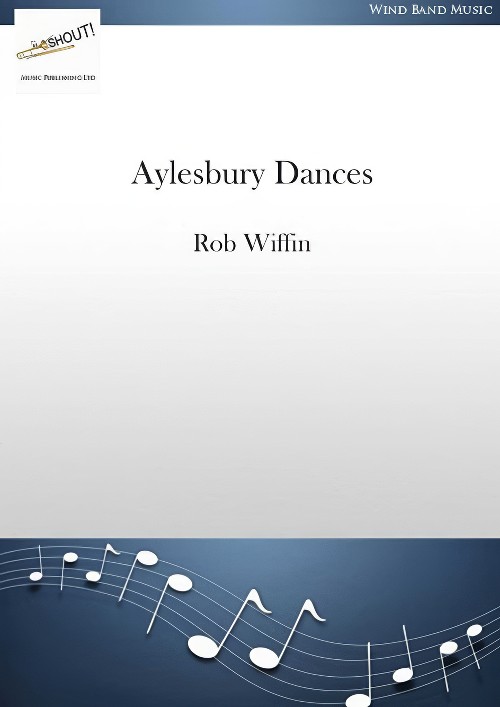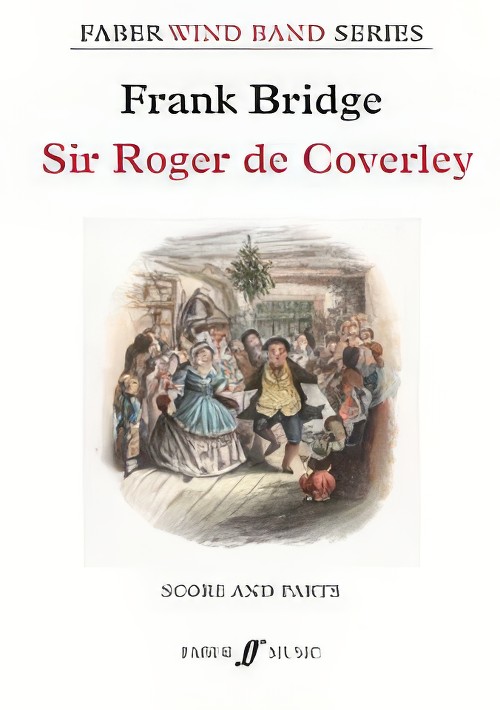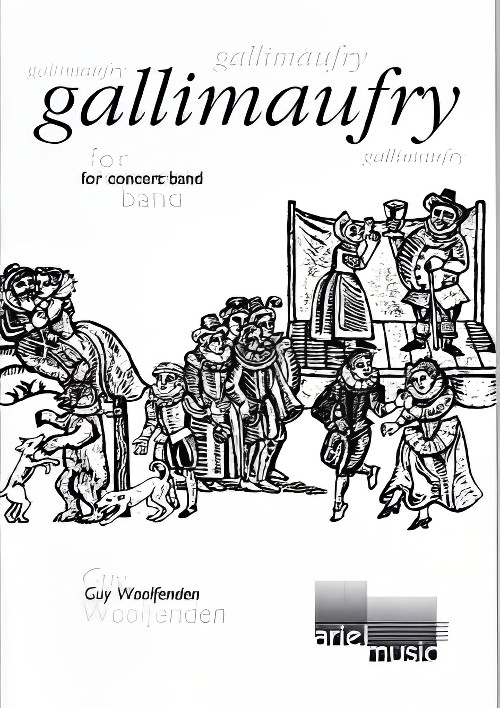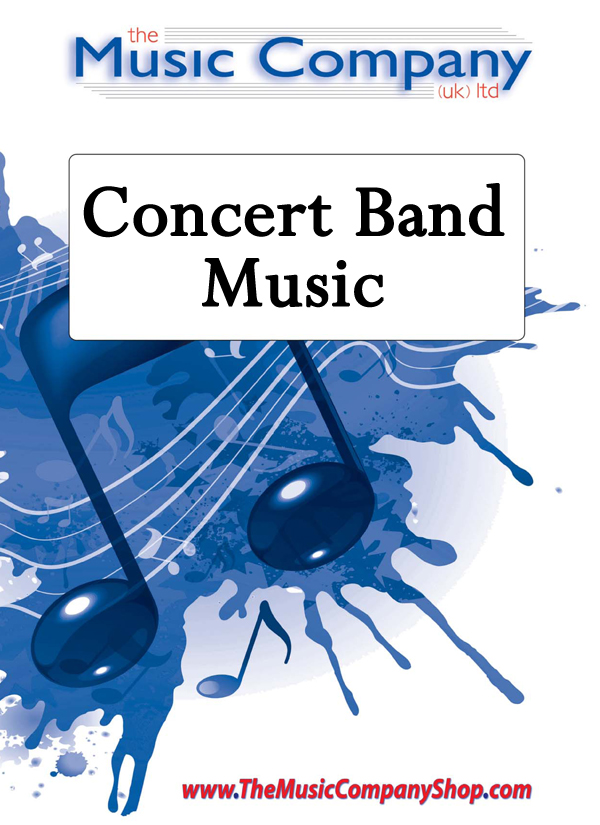Results
-
 £69.95
£69.95Aylesbury Dances (Concert Band - Score and Parts) - Wiffin, Rob
The suite Aylesbury Dances was commissioned by the Aylesbury Concert Band to mark the occasion of their 25th Anniversary in 2019. Its three movements depict different aspects of Aylesbury: I. Pavane: The Town - Having read something of the town's history and its architecture I decided I wanted to write something ceremonial with the feel of music from Tudor times. Aylesbury was given its charter and borough status in 1554 by Mary Tudor so I took that as my starting point but then added some harmony that moves forward in time. This fits with the town's motto: Semper Prorsum (Always forward) and also with the Band's evolution from Aylesbury Town Band to Aylesbury Community Concert Band to Aylesbury Concert Band. The music can be defined as a pavane, or a cortege. The sense of procession is slightly disturbed by a 'Blue Leanie' moment. The Blue Leanie is an iconic Aylesbury building, an oblique rhombic prism which stands at an angle of 17% inclination. I took a quaver out of the time signature (I know the maths don't work!) to reflect this and added some bluer harmony at that point. This opening movement gives a sense of the grandeur and heritage of Aylesbury town and a chance for my friends from the brass section to warm up! II. Siciliana: Waterside - To balance the outer two movements, the middle movement of the suite has a slow lilting 6/8 rhythm. It is in the style of a Siciliana, a dance form originating in the baroque era. It is a graceful, tender and melancholic dance, cast here in a minor key and featuring the dark voice of the cor anglais. The Siciliana was often linked with pastoral scenes and Aylesbury itself sits amid some beautiful countryside. It may, therefore, seem a bit of a stretch to call this movement 'Waterside', especially as Aylesbury is so far from the sea, but the town has a theatre of that name and that was the genesis for this particular music. There is a statue of Ronnie Barker in the grounds of the Waterside theatre as he started his career in repertory theatre in Aylesbury, so I included a fleeting reference to the theme music of the comedy programme 'Open all Hours'. III. Frolic: Ducks in a Row - It was impossible to write a piece connected with Aylesbury without considering the famous Aylesbury ducks. Duck rearing was a major industry in the town in the 19th century. The white Aylesbury Duck is a symbol of the town, appearing on its coat of arms and in the logo of the Aylesbury Concert Band! This movement is all about trying to get the little darlings in a row so they can sing their 'Duck Chorus' together but they keep on scattering, flying off or swimming away as quickly as they can manage. It's a bit like watching ducks disperse when my dog jumps into the stream after them. Eventually we get more of them in a row - even though they protest. Hidden amongst the ducks is a reference to Erica Miller, saxophonist and chairman of the band, and there's even a veiled reference to a shark in the hope of getting them out of the water. Ducks in a Row is a fun romp bringing this suite of Aylesbury Dances to a suitably celebratory conclusion.- Rob Wiffin.Duration: 9.15
Estimated dispatch 7-14 working days
-
 £79.99
£79.99Sir Roger de Coverley (Concert Band - Score and Parts) - Bridge, Frank - Wheeler, Alastair
Frank Bridge (1879 - 1941) was one of the leading English composers of his time. In October 1922 he adapted his popular string quartet Sir Roger de Coverley for full symphony orchestra and Sir Henry Wood agreed, at the last minute, to include it in the last night of the Queen's Hall Promenade Concerts at the end of that month. This elaborate and colourful orchestral version has never been widely performed, but has now been brilliantly transcribed by Alastair Wheeler to provide a miniature dance poem for grade 5 level concert band. Bridge's lively treatment of one of England's most famous traditional dance melodies will make a fitting end to any concert, with the strains of Auld Lang Syne introduced by Bridge as a nod towards Sir Roger de Coverley's traditional function as the final dance of a Christmas Ball, as it was in Old Mr. Fezziwig's party in Dickens' A Christmas Carol.
Estimated dispatch 7-14 working days
-
 £140.00
£140.00GALLIMAUFRY (Concert Band) - Woolfenden, Guy
Gallimaufry (gali maw'fri): A medley; any confused jumble of things; but strictly speaking, a hotch potch made up of all the scraps of the larder. cf Shakespeare: The Winter's Tale: "a gallimaufry of gambols"I. Church and StateII. Inn and OutIII. Starts and FitsIV. Father and SonV. Advance and RetreatVI. Church and Status QuoGallimaufry was inspired by Shakespeare's Henry IV plays, and derives from music I composed for the Royal Shakespeare Company's production which opened the Barbican Theatre in 1982. The score is dedicated to Trevor Nunn, then Artistic Director of the RSC, with grateful thanks for his suggestion that I should expand and mould the music from these productions into a form suitable for concert performance.My thanks also to Timothy Reynish and the British Association of Symphonic Bands and Wind Ensembles who, with funds provided by North West Arts, commissioned the work and helped to ensure its first performance on September 24th 1983 with the Royal Northern College of Music Wind Orchestra.The work is continuous and the thematic material of each of the six sections closely related. The "establishment" - leadership, temporal and ecclesiastical power - are depicted in the stately march which opens the work. (Church and State)The second section, Inn and Out, in an energetic hemiola rhythm, is concerned with the stews and low-life revels at the Boar's Head Tavern. This is interrupted and finally integrated with the Tavern Brawl and Gadshill Ambush of Starts and Fits.The mood changes and the ambivalence of Prince Hal's relationship with his father and surrogate father, Falstaff, is portrayed in a serene cor anglais solo. (Father and Son)Advance and Retreat is a recruiting march, derived from the Tavern Tune and leads into the last movement, Church and Status Quo, which deals with the rejection of Falstaff and the crowning of Price Hal. Order is restored with a majestic affirmation of the opening material.
Estimated dispatch 7-14 working days
-
 £98.50
£98.50Eternal Flame - Brian Balmages
This thrilling and majestic overture by Brian Balmages pays homage to the only eternal flame memorial in the United States dedicated to Medal of Honor recipients. Subtle nods to "America" remind the listener of the incredible sacrifices made by these brave individuals. While the piece is not overtly patriotic, the olympic-style fanfares and stately themes make it more than suitable for such an occasion! (5:40)Recorded sound courtesy of the U. S . Marine Band. Use of the recorded sound does not constitute or imply endorsement by the Department of Defense, U.S . Marine Corps, or U. S. Marine Band.The terms U.S . Marine Band and "The President's Own" are trademarks of the U.S . Marine Corps, used with permission.
Estimated dispatch 7-14 working days
-
 £225.99
£225.99Los Libros Olvidados - Johan de Meij
1. Barcelona 19452. Los Libros Olvidados - El Cementerio3. Las Ramblas - Els Quatre Gats4. Coubert - El Hombre sin Rostro5. Bea (Beatriz)6. El Inspector Fumero7. La Ciudad de las SombrasThis is a story wrapped within a story that unfolds in Barcelona 1945, following World War II. The protagonist, Daniel Sempere, is the teenage son of an antiquarian book dealer, who one day takes him to the Cemetery of Forgotten Books, a mysterious place with labyrinthine corridors where rare and banned books are stacked in massive dusty piles. His father tells Daniel to select a book, but it will be his responsibility to protect it. Daniel picks La Sombra del Viento (The Shadow of the Wind), a novel by a forgotten author Julin Carax. Daniel immediately starts reading the book, and the story unwinds itself into a compelling and complicated plot. As he reads, Daniel finds himself and his own life merging into the story's plot. It transpires that there is a mysterious man named Lan Coubert ('the man without a face') who is determined to destroy all copies of Carax's books. Daniel is threatened by Coubert and is determined to find out what happened to Carax, who fled to Paris and subsequently disappeared. Daniel finds that his own life has much in common with the author's. The book mixes magic realism, page-turning mystery, and Daniel's own real life. Daniel's once ordinary teenage existence is now filled with larger-than-life colorful and at times, terrifying characters. Among them are Fermn Romero de Torres, a beggar who Daniel and his father befriend and employ in the family bookstore; the evil police inspector Javier Fumero, who could be compared to Scarpia in Puccini's opera Tosca or Javert in Les Misrables. The corrupt Fumero uses the war as an excuse to practice his sadism and is widely feared in Barcelona. He is represented in the music by a fascist military march. The city of Barcelona becomes a character in the book and in the music. The Ramblas, the boulevard running through Barcelona's Gothic Quarter and the famous caf Els Quatre Gats (the four cats) come alive in the score through a Cobla, the traditional wind ensemble playing a sardana, typical Catalan folk music. Two parallel love stories turn up the heat: Julin Carax's passionate, forbidden love for Penlope, and Daniel's equally passionate and forbidden love for Beatriz (Bea). Bea's sultry love theme is based on the first three letters of her name, with the ascending intervals B-E-A. Johan de Meij New York, October 17th, 2023
Estimated dispatch 7-14 working days
-
 £85.00
£85.00Sir Roger de Coverley - Frank Bridge
Frank Bridge (1879 - 1941) was one of the leading English composers of his time. In October 1922 he adapted his popular string quartet Sir Roger de Coverley for full symphony orchestra and Sir Henry Wood agreed, at the last minute, to include it in the last night of the Queen's Hall Promenade Concerts at the end of that month.This elaborate and colourful orchestral version has never been widely performed, but has now been brilliantly transcribed by Alastair Wheeler to provide a miniature dance poem for grade 5 level concert band.Bridge's lively treatment of one of England's most famous traditional dance melodies willmake a fitting end to any concert, with the strains of Auld Lang Syne introduced by Bridge as a nod towards Sir Roger de Coverley's traditional function as the final dance of a Christmas Ball, as it was in Old Mr. Fezziwig's party in Dickens' A Christmas Carol.
Estimated dispatch 7-14 working days
-
£65.99
Santa's Magical Midnight Ride - Shaffer
The story tells it all: Santa Claus is on his way! His sleigh is filled with gifts! The weather is clear, perfect for the reindeer to guide him on his Christmas Eve trek. Away we go! Santa knows how to put on a show. He's getting closer, above the roofs, and as he descends, you'll hear the reindeer hoofs. Toward the chimney Santa goes, hoping he fits...oh no... it's a tight squeeze! As he lands with a thump, but Santa's all right; he never fails! After all, he's tough as nails. Recovered from his fall he leaves presents for one and all. Then back to the sleigh, so much to do. Don't worry, he won't forget about you. The stars will always be his guide on "Santa's Magical Midnight Ride!" Scored for maximum sound effects within the percussion section, this will be the hit of any holiday concert!
Estimated dispatch 7-14 working days
-
 £123.95
£123.95Fanfare on Amazing Grace - Adolfus Hailstork
Originally composed for solo organ, Hailstork's fanfare is a 3-minute explosion of joyous sound inspired by the Baroque-era tradition of Chorale Preludes. As in Bach's organ preludes, the familiar hymn's phrases broadly emerge from ornate counterpoint, here in the form of brass fanfares. The result is exhilarating! Also scored by Hailstork for chamber ensemble and for orchestra, FANFARE ON AMAZING GRACE was transcribed for concert band in January 2021 by MGySgt Don Patterson, staff arranger for "The President's Own" United States Military Band, for that ensemble's worldwide broadcast performance at the 2021 Presidential Inauguration.
Estimated dispatch 7-14 working days
-
 £78.99
£78.99Benjamin Franklin and the Art of Music - Robert W. Smith
Benjamin Franklin's love for the art of music was well documented in American history. Robert W. Smith has selected three musical moments in Ben Franklin's life and created this unique composition for the concert band. Beginning with a setting of "My Plain Country Joan." a song composed as an anniversary gift to his wife, Franklin's jovial personality is evident through the timelessness of his music. The second section is based on Franklin's glass armonica. The delicate and ethereal sounds of this beautiful instrument provide a quiet moment of reflection for all. The finale is based on Franklin's "magic squares." an arrangement of numbers in a square where all rows, columns and diagonals add to the same sum. Robert W. Smith extracted the melody based on the numeric sequence in a 3 x 3 magic square. The resulting musical statement and fugue truly shows the close relationship between mathematics and music. An amazing concept, an amazing cross-curricular piece!
Estimated dispatch 7-14 working days
-
 £55.00
£55.00The Declaration of Arbroath - Andrew Duncan
Programme notes from the composer, Andrew Duncan:Originally written for The West Lothian Schools' Annual Concert 2006 and scored for Concert Band, Brass Band, Highland Bagpipes, Children's Choir and Narrator. This version has been rescored for Concert Band with optional parts for Highland Bagpipes and Narrator. The piece celebrates the internationally renowned Declaration of Arbroath. The music begins in the uncertain times of Scotland's early 14th century, following the Battle of Banockburn and the death of William Wallace. The narrator describes this scene and explains the origins of the Declaration. The music builds to a climax, but once again gives way to uncertainty, allowing the narrator to explain further the history surrounding the Declaration. A group of Scottish Nobles wrote the Declaration which was an appeal to the Pope to recognize Scotland's independence. The piece then reflects a positive outcome following the Pope's support of the Declaration. Further information is provided by the narrator which draws to a rousing build to express the emotive inspiration behind this composition.The original scoring (to include Concert Band, Brass Band, Highland Bagpipes, Choir and Narrator) is also available by request.
In stock: Estimated delivery 1-3 days
